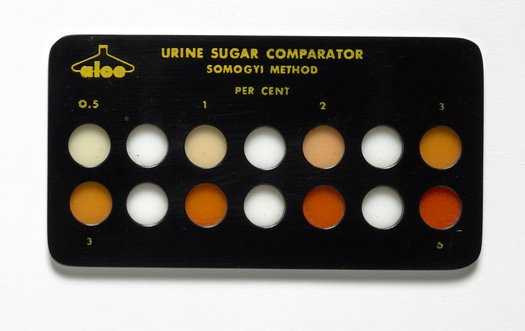Urine sugar comparator
- 1930 – 1950

Rights
 BY 4.0
BY 4.0Download all 2 images
PDFZIPof full-sized JPGsDownload selected image
Small JPG1200 x 756px — 116 KBLarge JPG2880 x 1815px — 603 KBFull-sized JPG3946 x 2487px — 1.0 MBOriginal fileTIFF — 3946 x 2487px — 28.1 MB
 This work is licensed under a Creative Commons Attribution 4.0 International License.
This work is licensed under a Creative Commons Attribution 4.0 International License.This plastic comparator for the Somogyi Method Urine sugar test likely belonged to Dr. Michael Somogyi (1883-1971). Contains yellow printing with a fabric case. This screening device is used to determine glucose levels in urine, which may be an indicator of diabetes.
Dr. Michael Somogyi (1883-1971) was a Hungarian American professor of biochemistry at Washington University and the Jewish Hospital of St. Louis. He determined that excessive insulin in the bloodstream causes instability in diabetes patients. He published his findings in 1938, which was coined the "chronic Somogyi rebound," and also explained the phenomena of elevated blood sugar levels that are present in the morning. He prepared the first insulin treatment in the United States in October 1922, which was given to a child with diabetes.
| Property | Value |
|---|---|
| Manufacturer | |
| Place of manufacture | |
| Format | |
| Genre | |
| Medium | |
| Extent |
|
| Subject | |
| Rights | Creative Commons Attribution 4.0 International License |
| Credit line |
|
Institutional location
| Department |
|---|
Related Items
Cite as
Science History Institute. Urine Sugar Comparator. Photograph, 2020. Science History Institute. Philadelphia. https://digital.sciencehistory.org/works/rbyk4vl.
This citation is automatically generated and may contain errors.







